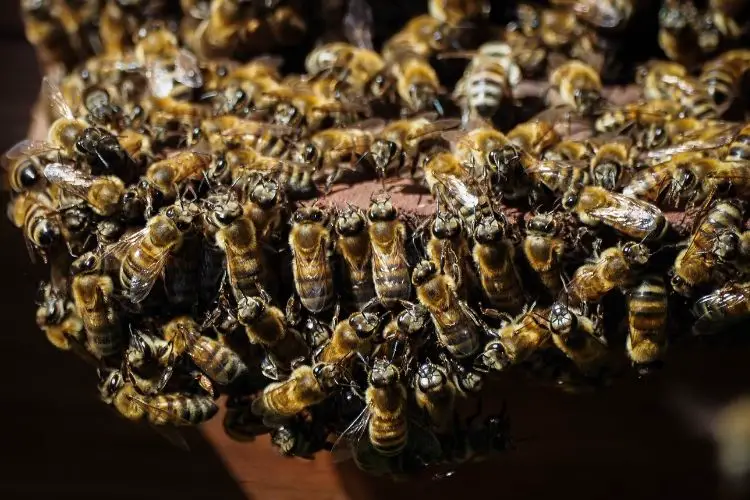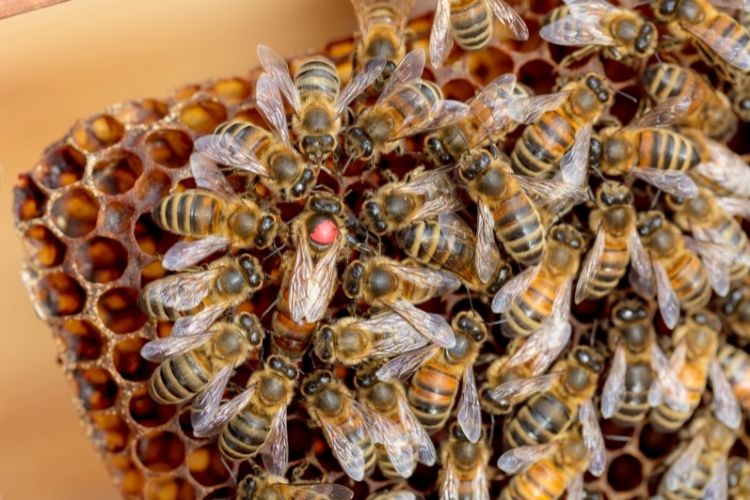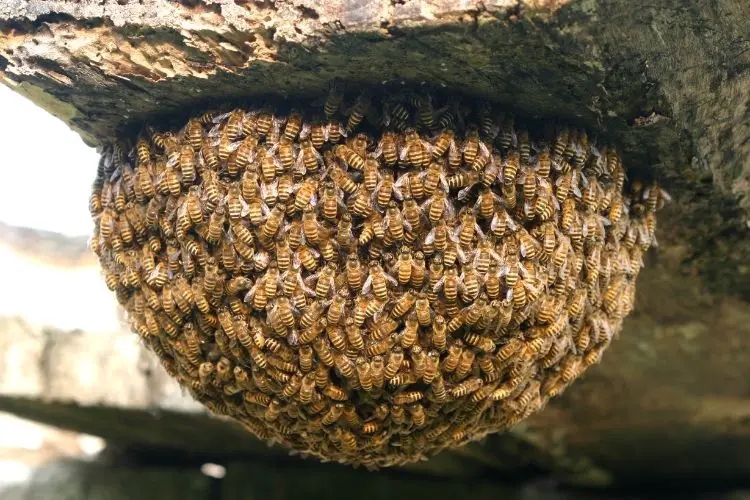Honey bees are fascinating insects. They work cooperatively with thousands of other bees as part of a huge colony that’s known as a super organism.
Sometimes, honey bee behavior may seem strange to us, but there is almost always a logical explanation for their actions. All their behaviors are aimed at maintaining the survival of the colony.
Let’s take a look at 8 unusual honey bee behaviors below.
1. Bees Cluster Outside The Hive At Night When It’s Too Hot
It might seem odd when thousands of honey bees cluster outside the front of the hive when the weather is hot – but it’s completely normal behavior and the sign of a healthy hive.
This behavior, known as bearding, typically happens at the end of the day when foraging bees return to the hive. They cluster together near and above the entrance. The cluster’s shape looks a bit like a beard, hence the name.

The colony will beard outside to maintain the internal temperature of the hive between 90 to 97 degrees Fahrenheit, or 32 to 36 degrees Celsius. This is the temperature required for the brood to survive. Any hotter and the brood will begin to die, or not develop properly, which can seriously threaten the colony’s existence.
Bearding also controls the amount of moisture within the hive. Too much moisture and the nectar can’t be sufficiently evaporated into honey.
The moisture content of honey is typically between 17% and 21%. So, the bee’s beard outside the hive reduces the numbers inside, allowing for more airflow inside the hive.
2. Bees Fan Their Wings To Cool The Hive Down And Direct Returning Foragers
Another unusual behavior is seeing worker bees furiously fanning their wings at the front of the hive. Like bearding, fanning also aids with temperature and moisture control during warm weather.
Inside the hive are more worker bees fanning their wings so that the fresh air is carried throughout the hive.
This behavior allows the colony to fulfil two aims: firstly, to maintain a constant temperature for the successful development of brood and secondly, to evaporate excess moisture from the nectar so it can become honey.
Honey bees perform another fanning ritual that might seem odd to us. Worker bees may be seen near the hive entrance vibrating their wings while raising their abdomens in the air. This behavior isn’t anything to do with temperature or moisture control. It’s used to direct worker bees back to their hive.
Bees have a gland at the tip of their abdomen, called the Nasanov gland. While exposing their abdomen, bees fan their wings to release a pheromone from this gland which helps foraging bees return to their hive.
3. Bees Sometimes Rock Back And Forth On The Front Of The Hive
Another strange honey bee behavior that has been observed is washboarding. Bees rock back and forth across the front of the hive, with their legs, antennae and mouth parts touching the hive as they go.
This action makes is seems as though the bees are cleaning the front of the hive. It’s called washboarding because it looks like they are scrubbing clothes on a washboard.
No one really knows why bees perform this odd routine, but there are a few different theories as to why bees washboard.
One theory is that bees are in fact cleaning and polishing the hive as they rock back and scrape the surface with their mouth parts. Bees are very fastidious insects that like to keep the hive clean both inside and out.
Another theory that endeavors to explain washboarding behavior suggests that worker bees are releasing pheromones from their Nasanov and tarsal glands to help foraging bees find their own hive entrance. The rocking back and forth movement could help disperse the pheromone.
One thing we do know about washboarding is that it’s more common in a colony that’s collecting a lot of pollen. Research has suggested that bees could washboard to remove pollen grains from their bodies.
The minute pollen grains can become lodged between the head and thorax which causes the bee to become uncomfortable, so to remove them they washboard.
A separate study into why bees washboard has revealed the following insights:
- Bees that washboard are between 15 and 25 days old.
- Washboarding behavior can begin as early as 8am. More bees join in until the numbers peak around 2pm and can continue until after the sun has set.
- Washboarding behavior is seen in worker bees.
- Given a choice, worker bees prefer to washboard across rough rather than smooth surfaces.
4. Bee Hives Have Only One Queen (And She Kills Any Rivals)
You might think that having only one queen to reign over a colony of many thousand bees is strange, but there are very good reasons why this is so.
A honey bee colony only has one queen, whose job it is to lay thousands of eggs to ensure the colony’s survival. If a new queen is needed, several queens are reared to give the colony the best chance of having a strong viable one.

However, only one of them ever survives because a hive can only have one queen. This is because the queen emits pheromones that seem to help control the daily functions and tasks within the hive. So, the first queen to emerge kills the others by tracking down their queen cells and stinging them.
5. Bees Sometimes Steal Honey From Other Bees (Known As Robbing)
You might sometimes see a lot of activity at the entrance to a honey bee hive, with many bees flying in and out at once, and others wrestling with each other, both at the front of the hive and on the ground below.
This strange activity is called robbing. Robbing occurs when bees from a different hive or other insects like wasps, steal the honey from a weak colony.
A weak colony doesn’t have enough bees to defend itself from such an attack. The guard bees that protect the entrance will fight to the death to defend their hive and stop it being robbed.
Bees rob other hives when there is a shortage of nectar and pollen. You’re less likely to see robbing occur when there is a nectar flow with lots of plants in flower.
6. Bees Swarm As A Means Of Reproduction
Swarming is a natural behavior that a colony uses to manage its growth and survival. Experiencing this unfamiliar event for the first time is exciting if not a little scary.
Swarming happens during spring and early summer when there is plenty of available nectar and pollen. If conditions are beneficial a bee colony grows rapidly and soon will need more room to expand. Approximately half the colony, including the original queen, leave the hive to find a new place to live.
Bees intending to leave get prepared by gorging themselves full of honey about a week beforehand. At the same time, the queen is actually deprived of food to make sure she is thin enough to fly with the swarm.
On a fine day, usually, between the hours of 10 am and 2 pm, the swarm leaves the hive and settles nearby, clustering together on a suitable surface. The queen is protected in the center of the swarm.

Scout bees leave the cluster in search of a suitable home, which could take anywhere from a few hours to a few days. Once found, the swarm takes off to its new home to establish a new colony.
To ensure the continuity of the colony that’s left behind, several queen cells with developing larvae inside are prepared in the lead up to a swarm. The first queen to emerge kills her rivals before they hatch. She then mates and returns to the old hive to take over from the queen that’s departed with the swarm.
7. Bees Communicate By Dancing
Yet another honey bee behavior you might find strange are the dances performed by bees to communicate information about available pollen, nectar and water.
Foraging bees returning to the hive dance to indicate the location and type of food they have discovered. The information is then used by other foraging bees to find the food source.
There are two types of dance performed, the round dance and the waggle dance. The round dance lets the foragers know the food source is close to the hive, whereas the waggle dance indicates the food source is further away.
In the waggle dance, the foraging bee shivers her abdomen from side to side while moving across the comb in a figure eight pattern. The number of times she performs the dance, and the energy with which she waggles, gives the other foragers explicit information about the whereabouts of the food source.
To ensure her message is delivered, she pauses briefly between dances to offer a sample of the food she has collected. This tasting offers extra information about the type of food and its location.
8. Bees Only Poop Outside The Hive
Honey bees keep their hive very clean to ensure the colony remains healthy, so when they leave the hive they poop while in flight.
You may have wondered what the strange, small mustard color droplets are on your car or on your drying washing. Sometimes the mustard droplets are more of a smear. It just depends on how high the bee is flying at the time. If there are bees near where you live it’s more than likely bee poop.
You’ll see more of these stains during spring when the weather is fine and plants are flowering because bees are much more active then. They’ll be out collecting nectar and pollen to feed the colony.
It’s important that the hive is clean to prevent disease. The workers within the hive remove the poop of the queen, the drones, and the developing brood too. They deposit it outside the hive, so some mustard smears on the front of your hive is normal.
The workers even remove dead or dying bees. It’s like taking out the garbage before it smells.
Another amazing behavior of bees is holding their poop in until the weather is warm enough for them to leave. Then, they’ll make special cleansing flights.
Final Thoughts On Strange Or Unusual Honey Bee Behavior
Bees are amazing insects and there is still so much about their unknown behavior. I think that’s why I find them so fascinating.
Although some of their actions may seem odd to us, all their behaviors are intentional and for one purpose – to maintain the colony’s health and ensure its survival.
In turn their survival ensures we as humans can enjoy a varied, healthy diet. Without bees to pollinate them, many of the foods we enjoy today wouldn’t be available to us. That’s one of the reasons I have bee hives in my garden.
